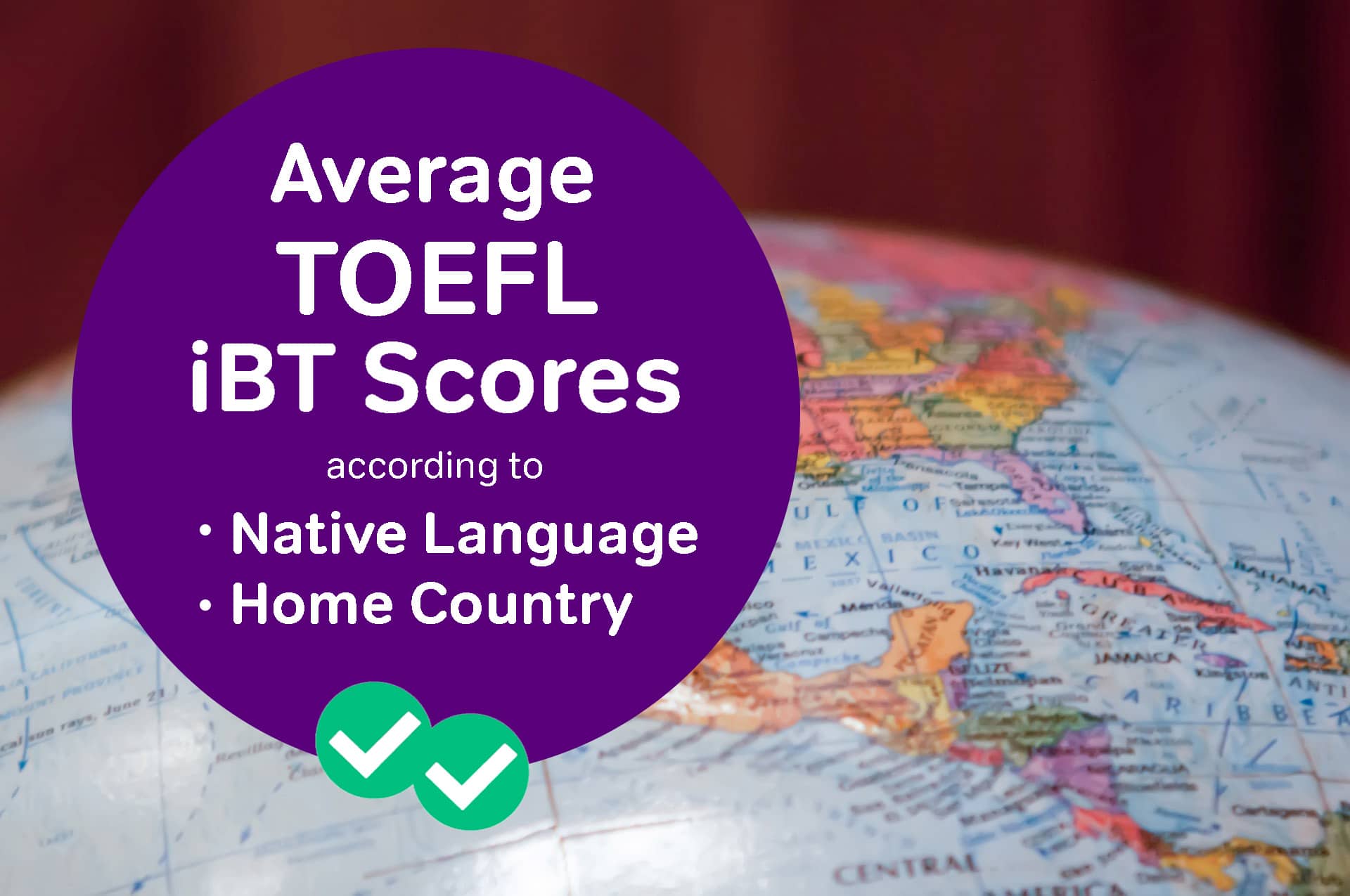
Every year, ETS releases a report on average TOEFL scores. Their Test and Score Data Summary for 2017 includes averages by native language and nationality. The detailed data in the report is a very interesting read. Below, I’ve outlined some of the most important data about average TOEFL scores for different countries and different groups of language speakers.
Average TOEFL iBT scores by native language
ETS gives data on test-takers from many different language backgrounds. It’s especially interesting to see the average scores for speakers of Middle Eastern, East Asian, Indian, and Romance languages. People from these language groups make up the majority of international students who come to American universities. Here are some statistics on average TOEFL scores by major language groups:
- Native Chinese speakers: 79
- Native Korean speakers: 84
- Native Vietnamese speakers: 82
- Native Arabic speakers: 78
- Native Farsi speakers: 83
- Native Turkish speakers: 78
- Native Assamese speakers: 99
- Native Hindi speakers: 96
- Native Bengali speakers: 93
- Native Spanish speakers: 85
- Native Portuguese speakers: 87
- Native Italian speakers: 91
It’s also interesting to note which native language groups had the highest and lowest average scores. The six language groups with the highest average TOEFL scores are Dutch (100), German (99), Assamese (99), Kinyarwanda (99), Kashmiri (98), and Danish (98). In contrast, the six groups of language speakers with the lowest average TOEFL scores are speakers of Kurukh (59), Mossi (59), Lingala (61), Kurdish (61), Bambara (61), and Fulah (61). Even more interesting? The TOEFL keeps data on native English speakers who take the TOEFL, and they are not at the very top of the list. Native speakers of English have an average TOEFL iBT score of 91!
Average TOEFL iBT scores by country
The TOEFL’s 2017 report on average scores lists the scores of nations and territories by region. Here are the top and bottom scoring countries and territories from each of the TOEFL regions:
Africa:
- Top average TOEFL scores: South Africa (98), Mauritius (95), Zimbabwe (88), Botswana (88)
- Bottom average TOEFL scores: Congo (60), Djibouti (60), Guinea (61), Mali (63)
The Americas
- Top average TOEFL scores, English speaking states: Trinidad and Tobago (96), Canada (95), Bahamas (94)
- Top average TOEFL scores, non-English speaking states: Costa Rica (93), Uruguay (91), Nicaragua (88)
- Bottom average TOEFL scores: Haiti (63), Guadeloupe (77), Martinique (77), Netherlands Antilles (79)
- NOTE: Because there a quite a few countries in the Americas where English is the dominant language, I felt it would be helpful to show the top 3 for both English and non-English nations/territories. Interestingly, Costa Rica and Uruguay, Spanish-speaking countries, have higher average TOEFL scores than the English speaking American nations of Antigua & Barbuda (90) and the USA (89). Also note that, as you would expect, the bottom average TOEFL scores are all associated with non-English speaking locales.
Asia
- Top average TOEFL scores: Singapore (97), India (94) Pakistan (92)
- Bottom average TOEFL scores: Laos (59), Tajikistan (66), Japan (71), Afghanistan (71)
Europe:
- Top average TOEFL scores, non English-speaking countries: Austria (100), Netherlands (100), Belgium (99), Switzerland (99), Denmark (98), Germany (98)
- Top average TOEFL scores, English-speaking countries: Ireland: (101), United Kingdom (96)
- NOTE: As I did with North America, I am listing the top English speaking nations separately from the top-non-English-speaking nations. And once more, we see that non-English speaking countries can be very competitive with the English speaking ones. The top 5 non-English countries all have higher average TOEFL scores than the UK. And Ireland’s TOEFL average is only one point higher than that of Austria and the Netherlands!
- Bottom average TOEFL scores: Armenia (78), Turkey (78) Albania (81)
The Pacific Region
NOTE: In many years, the number of TOEFL test-takers in any given Pacific Region nation is so low that no significant statistics are generated. In its 2017 report, ETS only collected stats on 3 countries in this part of the world. So I’ll also include the 2016 stats in the single list below, in order from highest TOEFL score to lowest. Once more, I am listing the stats for English-speaking and non-English-speaking nations separately.
- Average TOEFL scores for English-Speaking Pacific Region countries (2017): New Zealand (95), Australia (92)
- Average TOEFL scores for non-English speaking Pacific Region countries and territories (2016 & 2017): French Polynesia (78), New Caledonia (80), Papua New Guinea (73)
The takeaway
As you can see, certain language groups and countries seem to be “better” at TOEFL than others. By looking at the information above (and the additional information in the full ETS report), you can see where your country and language group stands. Do you need to beat your group’s average to get a top TOEFL score? Or do you just need to meet your group’s average to do well on the test? Knowing this can help you as you plan your studies and set your target score.
Additionally, certain factors help determine whether a nation, territory, or group of language speakers will have good average TOEFL scores. Understanding these factors is useful too. If you know why your group has the average TOEFL score that it does, you can work to overcome your group’s weaknesses on the TOEFL. Or if your language/national group has high average TOEFL scores, you can take advantage of the resources your group has, making sure that you meet or pass the group average.





